"Earth as a Simulation Series 4: This Series offers MANY pages of Evidence that many Anomalous Experiences, Plus 'Exceptional' Abilities & Skills can be explained 'IF' we are Simulated copied people being Simulated with Less Advanced Technologies resulting in ourselves having Anomalous Experiences that relate to Hi-Tech Neural Implants & CNS Enhancements that the person we are simulating HAD, but which we are a long way from developing here!!!"
Main Page Headings List
- What Visual Sensory Anomalous Effects would Suggest that Human 'Vision' is being Processed & Handled as Digital Data?
- Synesthesia, a 'Condition' that Strongly Displays Sensory Mixing & Digital Transformation Highly Suggestive of a Neural Implant
- Why do Grapheme-Colour Synesthesia Abilities & Skills 'ALL' seem to Enhance Visual TEXT Presentation in Various Ways?
- Grapheme-Colour Synesthesia Skills Strongly 'Suggest' a Neural Implant 'AID' Focused on Writing Skills, Spelling & Memory Retention?
- Why do people have Grapheme-Color Synesthesia? Perhaps to help Speed-up Learning of the Alphabet, Grammar, Spelling & Writing?
- More Speculation of Human 'Digital' Characters & Optical Character Recognition of Grapheme-Colour Synesthesia Possibilities
- Grapheme-Colour Synesthesia 'Digital' TEST 1: Recognition of vertical and angled text 'test':
It is highly likely that neural implants that are spliced into sensory input feeds would handle and also manipulate the ‘sensory’ data ‘digitally’. Specifically it is highly likely that many neural implants would DIGITISE sensory input AND for many implant functions this now digitised data would be manipulated, processed and for specific ‘applications’. In other words, any ‘perceived’ visual scene could be specifically altered and changed before being passed on and directly ‘experienced / viewed’.
Can you reading this spend time ‘NOW’ trying to imagine just ‘some’ of the utterly bizarre ‘weird’ DIGITAL EFFECTS that these types of neural implant originated digital conversions could result in and particularly for very specific types of neural implant that would depend on and process visual input and or which would use vision to present their output?
What Visual Sensory Anomalous Effects would Suggest that Human ‘Vision’ is being Processed & Handled as Digital Data?
For example, digitised visual / eye sight input and particularly of visual ‘views’ that include ‘text’ are likely to automatically have optical character recognition (OCR) software permanently active. OCR software specifically identifies written text character by character, it could even identify which font the text is using. In other words OCR software specifically identifies each and every individual character in digitized documents.
Once OCR software within a neural implant identifies a written character it would then be easy to apply alterations, overlay masks and even ‘substitutions’ to any characters that it isolates / identifies. For example it would be stupidly easy for a ‘vision’ focused neural implant with a built in OCR function to be able to identify and to then ‘highlight’ or apply an ‘overlay’ or a ‘transformation’ to any character such that each ‘letter or number’ character is then output in say a specific colour.
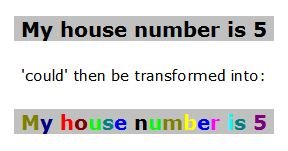 ‘IF’ someone had ‘natural’ COLOUR vision issues you would expect this to impact their entire ‘visual’ spectrum or more rarely specific areas of the eye. Read wikipedia colour blindness page for an overview of these possibilities.
‘IF’ someone had ‘natural’ COLOUR vision issues you would expect this to impact their entire ‘visual’ spectrum or more rarely specific areas of the eye. Read wikipedia colour blindness page for an overview of these possibilities.
Having absolutely anyone, even one person in the population consistently exhibiting visual presentations of letters and or numbers and particularly were any ‘character’ is consistently presented as a specific colour, AND ‘always’ that same colour, you’d imagine would . . .
- Be so utterly ‘anomalous’ while also representing . . .
- Effects that are ‘unmistakable’, as DIGITAL transformation effects . . .
That you would imagine that under these circumstances ‘someone’ somewhere would have queried how an assumed ‘natural’ organic ‘EYE’ could have evolved to automatically dynamically ‘apply’ consistent ‘digital’ transformation effects in unbelievably ‘specific’ ways AND consistently to very specific viewed shapes ‘coincidentally’ only found in written text?
Synesthesia, a ‘Condition’ that Strongly Displays Sensory Mixing & Digital Transformation Highly Suggestive of a Neural Implant
Coincidentally, there is a well documented condition called ‘Synesthesia’, which is a cover all term for many different individual, consistent but bizarre variations of what are essentially described as ‘mixed up senses’.
On wikipedia’s ‘synesthesia’ page one of the many sub conditions is called grapheme-color synesthesia which gives the following description:
“In one of the most common forms of synesthesia, individual letters of the alphabet and numbers (collectively referred to as graphemes) are “shaded” or “tinged” with a colour. While different individuals usually do not report the same colours for all letters and numbers, studies with large numbers of synesthetes find some commonalities across letters (e.g. A is likely to be red).”
Two, very interesting examples are given for this condition which indicate that grapheme-colour synesthesia effects are DYNAMIC, meaning that they are ‘INTELLIGENTLY’ RESPONSIVE in a MOMENT BY MOMENT SENSE.
1. As a child, Pat Duffy told her father, “I realized that to make an R all I had to do was first write a P and draw a line down from its loop. And I was so surprised that I could turn a yellow letter into an orange letter just by adding a line.”
2. Another grapheme synesthete says, “When I read, about five words around the exact one I’m reading are in colour. It’s also the only way I can spell. In elementary school I remember knowing how to spell the word ‘priority’ (with an “i” rather than an “e”) because … an ‘e’ was out of place in that word because ‘e’s were yellow and didn’t fit.”
In other words, for this particular ‘condition’ for both of the above people it ‘coincidentally’ and unbelievably functions as a:
Written word: Comprehension & SPELLING AID!!!!
Did you notice that for my ‘My house number is 5’ example I used a grey background?
This is because on a ‘standard’ white background it’s difficult to just ‘automatically’ read and ‘naturally’ comprehend what is written . . .
Why do Grapheme-Colour Synesthesia Abilities & Skills ‘ALL’ seem to Enhance Visual TEXT Presentation in Various Ways?
The ‘example’ graphic on the wikipedia page is also VERY revealing in this respect too, here it is below . . .
Compare the above to this ‘normal’ text version below:
Basically, you realise that UNBELIEVABLY, using slightly ‘blurred’ darker text when presenting coloured letters & numbers makes it much easier to read than ‘normal’ text. Coincidentally, people experiencing grapheme-colour synesthesia actually see the highlighted characters in a blurred, ‘easier to see and read’ form.
In another ‘experience’ description from here, we have more evidence of grapheme-colour synesthesia effects being correlated with helping people spell words correctly:
“Grapheme-colour synesthesia helps with memorization and recall of both numbers and words, due to the unique colour coding associated with each word or number. For example, homonyms such as “break” and “brake” evoke very different colour sensations within the mind of a synesthete, making it even simpler to distinguish between the two than through the distinction of spelling alone.”
The only conclusion that you can ‘realistically’ come to is that the specific effects described by these examples ‘coincidentally’ all help to maximise ‘facilitated’ writing, spelling, comprehension, memory retention and recall of what is written. Basically, many personal experience examples of those that have grapheme-colour synesthesia offer consistent evidence that ‘some’ people here have the ‘abilities’ that you would ‘expect’ if they had a writing, composition and spelling facilitating neural implant wired directly into their head.
On this site here I found a list of general synesthesia characteristics (I’ve added my own underlined ‘extension’ for one of the points in this list)::
- They are involuntary non-suppressible sensations (i.e. they are not ‘consciously’ invoked but are completely automatic (i.e. they appear to be ‘built in’ as ‘neurological’ functions)).
- The people with this condition have ‘felt/experienced/been aware’ of those sensations since they can remember.
- Environmental projection of sensations are not just in the mind, the person actually can feel it. For example, they can taste words or see colours listening to music.
- The ‘extra’ synesthesia sensations are consistent, generic and durable. For example, the sound of a bell stimulates a red vision every time.
- The feelings are usually emotional. Experiencing the sensations causes ecstasy and emotional fulfilment.
Basically, grapheme-colour synesthesia describes an entire set of highly anomalous ‘automatic’ (not consciously invoked) abilities and skills. These extended abilities, skills and ‘functioning’ (on the whole) could actually be described as examples of human ‘enhancements’. In fact, one of the pages linked above makes a point of stating that synesthesia is not listed in either the DSM-IV or the ICD (as a neurological condition) since it most often does not interfere with normal daily functioning. In other words, these ‘experiences’ are not taken as being something ‘bad’ such that efforts must be made to ‘correct’ or eliminate them.
Grapheme-Colour Synesthesia Skills Strongly ‘Suggest’ a Neural Implant ‘AID’ Focused on Writing Skills, Spelling & Memory Retention?
If we were to appraise the grapheme-colour synesthesia experiences in terms of our entire KNOWLEDGE BASE then we might find ourselves being able to state that, grapheme-colour synesthesia experiences and the consistent personal descriptions of these give the VERY STRONG IMPRESSION that they are actually describing some sort of BUILT IN spelling, language and writing comprehension learning aid.
Is this possible? How would we ‘rationally’ approach THINKING about this possibility in more depth?
Well, we could IMAGINE OURSELVES as being the hypothetical designer of a hypothetical language, writing comprehension and spelling aid neural implant and JUST FOR FUN we could evaluate these experiences as potentially being due to the functioning of a neural implant enhancement AND in THINKING about these possibilities we could then ask ourselves WHAT ELSE WOULD ‘LIKELY’ BE INCLUDED AS PART OF THE FUNCTIONING OF SUCH AN IMPLANT? What other functions would YOU design into a hypothetical writing, composition, language comprehension and spelling enhancement and particularly one that was being designed for use by young children?
Well, at an extreme (for the; ‘high end, no expense spared’ neural implant version) you might design such an enhancement to automatically transform alphabet letters and maybe numbers into ‘memorable’ as well as language and alphabet ‘meaningful’ cartoon characters!!!
As a hypothetical language, writing and spelling aid implant designer you could IMAGINE people using these ‘extra’ functions and you could then think about the types of ‘experiences’ that these ‘extra’ functions would result in? You could then look through the descriptions of grapheme-colour synesthesia experiences to see if anyone’s described experiences that match with what you can ‘deduce’ would be LIKELY for such an implant.
‘Unbelievably’ some people do see each letter in the form of a cartoon ‘character’ type person. The graphic below (taken from here) are the actual characters drawn from the descriptions given by someone with synesthesia whom consistently sees each letter as a cartoon type character some of which are presented below.
On that page, each of the cartoon characters ‘representing’ each LETTER of the alphabet is given a description written by someone that DOES actually see written letters in this form. Each ‘character’ in the above line up also has a distinct personality to.
For example the letter ‘I’ has the following BUILT IN attributes: Gender: Female, Colour: White, Personality: Meek, cautious, quiet, soft spoken, dreamer.
Now, in thinking about ‘everything’ above and spending time looking at the ‘characters’ (that we are ‘unbelievably’ expected to imagine that someone’s head has sub consciously ‘automatically’ picked to represent a specific written LETTER of the alphabet as in a ‘CHARACTER’ (of the alphabet)) then if this ‘IS’ part of some writing, spelling, learning aid neural implant then the characters are likely to be given names that will help in this way, i.e. they will facilitate understanding of the letters, their characteristics and even perhaps their ‘place’ in the alphabet (and often names that young kids would identify with / remember). For example:
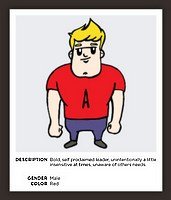 ‘A’ has defined attributes of: Male, RED: “Bold self proclaimed leader, unintentionally a little sensitive at times, unaware of others”.
‘A’ has defined attributes of: Male, RED: “Bold self proclaimed leader, unintentionally a little sensitive at times, unaware of others”.
The cartoon person representing ‘A’ is given a highly visible colour AND is visibly Athletic, in other words letter ‘A’ is represented by a BIG ‘Alpha male’ type, i.e. someone that would symbolically ‘BEST’ represent the ‘LEADER’, in this case, the first or LEAD character in the ALPHAbet. In other words, the cartoon character ‘A’ is likely named/called ‘Alpha’.
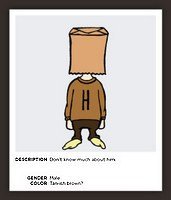 ‘H’ has defined attributes of: Male, Tan-ish Brown: “Don’t know much about him.”
‘H’ has defined attributes of: Male, Tan-ish Brown: “Don’t know much about him.”
The latter ‘H’ is found in words such as ‘Through / The / Them / Ought’ in other words, the ‘H’ character as in ‘heych or huu’ is often unexpressed i.e. verbally ‘H’ is actually often ‘Hidden’ within words, also the black ‘H’ on the brown background on the T-shirt of the figure above makes the ‘H’ one of the most ‘visibly’ obscured of the cartoon characters to, never mind that he’s got a completely obscuring bag over his head. The cartoon character ‘H’ is likely named ‘Hidden’.
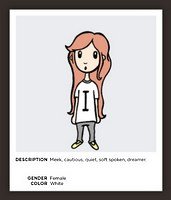 ‘I’ has defined attributes of: Female, White: “Meek, cautious, quiet, soft spoken, dreamer.”
‘I’ has defined attributes of: Female, White: “Meek, cautious, quiet, soft spoken, dreamer.”
The letter ‘I’ in being just one single vertical line could actually best be described as the most invisible letter of the alphabet. White is also the most ‘blend in’, nondescript, essentially ‘bland’ colour. Also, the cartoon person representing ‘I’ is also ‘THE’ thinnest character in the above line up. In other words the letter ‘I’ character is probably called ‘Invisible’.
Are we supposed to believe that, ‘all that I point out on above’, which you can deduce would be appropriate for and EXPECTED of a sophisticated writing, reading, spelling and written ‘comprehension’ learning aid neural implant are all just ‘RANDOM COINCIDENCES’?
Why do people have Grapheme-Color Synesthesia? Perhaps to help Speed-up Learning of the Alphabet, Grammar, Spelling & Writing?
Below are comments I’ve found on various web sites that actually somewhat ‘extend’, beyond what I have laid out above:
Some people also appear to have ‘spell checking’ built in even for different languages (from comments on here):
“When someone speaks to me in whatever language I am fluent in, I can ‘see’ the words written in my mind, like if I was reading their speech ?? I’ve been doing that ever since i was little, maybe 3 or 4 years old (I started to read and write at that age) and it never stopped. I don’t usually make spelling mistakes in a language because of that. Also, when I hear a new word, it’s automatically written correctly in my head. It’s weird, I feel like a dictionary – hahaha”
The comment below (from comments on here) is of someone that has dyslexia who didn’t notice that this was the case because the synesthesia compensated for this somewhat. Because of the synesthesia they can also speed read because what is written is translated into a moving picture that represents the meaning of what is written.
Any ideas as to how an assumed flesh and blood human ‘head’ could generate these types of sophisticated visual data manipulation skills?
“I have Synesthesia, but I also have Dyslexia. I didn’t realize I had either until later in High School because the Synesthesia translated the letters and words into colors, so I didn’t have to see the individual letters themselves. This only became a problem when the colors of the words was almost the same. For example, immortal is a pinkish-purple and immoral is two shades more purple. I have also noticed that the Synesthesia has turned me into a speed reader. For example, a trained speed reader (my sister) can divide the page into six sections and then read the different sections and then their brain puts the words into coherent order for them. I realized that I divide the page in half and look at the sequences of colors (words) on the top half, then the bottom half, then the meaning comes alive in my head in the form of a moving picture. It’s just really interesting.”
More Speculation of Human ‘Digital’ Characters & Optical Character Recognition of Grapheme-Colour Synesthesia Possibilities
There are two ‘strange’ things that I’ve noticed on the web pages I’ve read that discuss and also present ‘tests’ for those with grapheme-colour synesthesia. All, ‘tests’ of grapheme-colour synesthesia in terms of different characters being different colours ALL present the text in ‘digital’ form, with all of the characters in the ‘as expected’ upright orientation.
For anyone that has scanned a text sheet into a computer to have it converted into an editable document will appreciate how ‘finicky’ Optical Character Recognition (OCR) software actually is.
Basically, if the paper is not very ‘approximately’ up/down vertical then the software has problems identifying characters, with the result that any scanned pages that are significantly ‘skewed’ can result in entertaining but completely wrong character conversions.
So, my ‘enquiry’ here is, how well, how consistently and ‘accurately’ are the black text characters of the following ‘converted’ into the colours and or the cartoon characters as you’d ‘expect’?
Grapheme-Colour Synesthesia ‘Digital’ TEST 1: Recognition of vertical and angled text ‘test’:
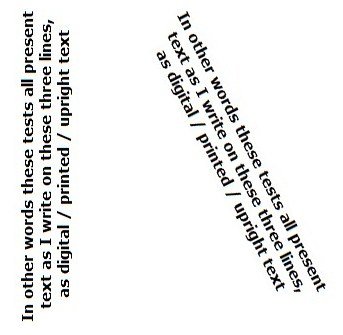
Can all of these reading this page that have grapheme-colour synesthesia leave comments to let us all know:
- How well is ‘natural’ writing ‘handled’ (coloured in / made into cartoon characters) compared to digital, printer defined fonts generated text?
- How well is wrongly orientated text ‘handled’ (coloured in / made into cartoon characters) compared to the expected ‘upright’ text?
For neural implants that originate within a high technology society, I’d expect people to ‘write’ in ‘digital’ text by sub-vocally or subliminally dictating the words of the text they want recorded to have this done (for e-mails, twitter, Facebook, diary entries, VR site comments etc). I’d then personally expect such a neural implant to preferentially handle text in a DIGITAL form and not ‘natural’ text.
Before reading the next page, can you think of any of the neural ‘implant’ possibilities that I already mentioned on the previous pages and then imagine what else would we expect in specific ‘word’ presentation terms that would also be evidence that we are simulating people with neural implants?
Hint, perhaps have a ‘think’ about the possibilities you would ‘expect’ of a neural implant that functions as a diary and which then might handle scheduling and maybe even offer a ‘to do list’?
Click the right >> link below for the next page in this series . .
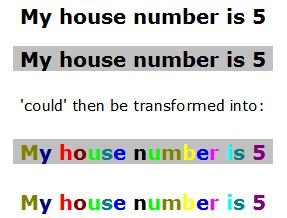
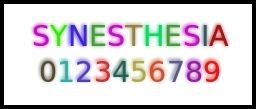
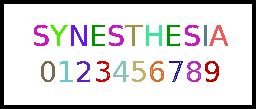



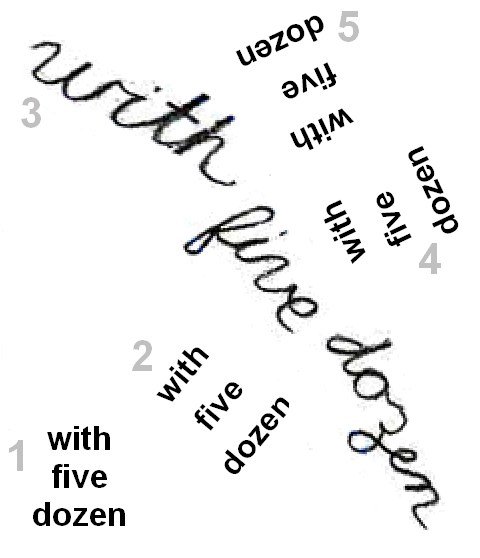

April 20, 2016 @ 3:20 pm
wow i have grapheme colour synesthesia and i remember that in the 2nd grade i hardly made spelling mistakes, it’s interesting.
April 21, 2016 @ 11:44 am
Hi Jessica, I’ve added a new section to the bottom of this page for people with grapheme colour synesthesia to see what happens then text is not strictly ‘vertical’ and also for writing that is in a ‘natural’ handwritten form rather than in a printed ‘standard’ letters ‘font’ form!!!
April 21, 2016 @ 5:42 pm
Ok, I’ll try to answer your questions according to my personal case.
Firstly, I don´t see literally colours directly on the characters as if they were tinged. What I have is a mental sensation of colour in certain characters (not all of them, to me all the numbers have associated colours, but the same doesn’t happen for all the letters). That sensation varies in intensity depending on my state of relaxation or mental activity, in the same way that some characters show more vivid colours than others.
In relation to the spell checking, I do not see the words that people say written in my head, but if I think in the correct way to spell a word then I see it as if it was written in my mind not only with the corresponding colours of each character but also with a colour sensation of the inherent word itself, as if there was a colourful atmosphere surrounding it.
Now answering to the questions, I get the colourful sensations as quickly as I can understand what is written, and this is valid both for the digital vs natural writing as for the horizontal vs vertical writing. Put in other words, the response speed “recognition/colourful association” is the same for both forms of text presentation (vertical/horizontal and handwritten/digital).
April 21, 2016 @ 8:18 pm
Hi Jessica,
It’s interesting that all of these text formats were recognized as the same for you:
Now answering to the questions, I get the colourful sensations as quickly as I can understand what is written, and this is valid both for the digital vs natural writing as for the horizontal vs vertical writing. Put in other words, the response speed “recognition/colourful association” is the same for both forms of text presentation (vertical/horizontal and handwritten/digital).
I wonder if this will be the case for everyone. I just heard from a coworker recently that they are phasing out cursive writing and even READING/ recognition from schools.
I have heard this from other people who were teachers or had children in schools in various areas. So this seems like it could be one possible piece of evidence or ‘sign’ which reflecting what Clive writes about society here:
For neural implants that originate within a high technology society, I’d expect people to ‘write’ in ‘digital’ text by sub-vocally or subliminally dictating the words of the text they want recorded to have this done (for e-mails, twitter, Facebook, diary entries, VR site comments etc). I’d then personally expect such a neural implant to preferentially handle text in a DIGITAL form and not ‘natural’ text.
So the children in the current generation no longer being able to write in or even RECOGNIZE cursive handwriting seems incredibly strange and would only really make sense if everything had originally ‘really’ gone digital more or less.
If the society we are simulating is as a lower technology society which is ACTUALLY living out the impacts and ‘habits’ of a higher technology society, then you could get some parents being completely taken aback that their children could no longer recognize simple cursive handwriting or ‘be culturally literate’ in this way when just a generation or two back everyone lived this way and worked/ wrote this way.
. . .
So it’d be something like a massive cultural change or shift with no context because we haven’t ‘converted’ everything to OCR here and we do have to use pen/ pencil and paper if we’re on the go (unless you write everything into your smart phone or tablet).
I.e. the entire society is not ‘wired in’ to some neural implant network / virtual network ‘physically’ (aha although you could argue we more or less ‘act’ that way with our smart phones and tablets and / or constant connection to ‘laptops’). But the differences are still significant enough for it to be noticeably NOTICED by older generations, and some are protesting the ‘phasing out’ of cursive reading / recognition and writing in schools I believe . . .
April 22, 2016 @ 9:54 am
Hey Matt, . . . ‘yea’, but despite that we’re accessing and investigating neural ‘implant’ possibilities directly and getting some ‘decent’ insights that are extending our understandings of them, we are doing this in ways that make it difficult to separate out individual trees from the entire wood/forest!!!
So, in synethesia comments a very few people describe what Jessica states, which is that they don’t actually ‘see’ the letters as ‘colours’ but they ‘feel / intuit / sense’ them as having colours / different attributes / parameters. So, I think/feel that Jessica is simulating someone that has a REAL WRITING implant, i.e. someone that uses and prefers REAL ‘WRITTEN’ writing, because such people would be more orientated to their feelings, inner states / insights and INDIVIDUALS DIFFERENCES & PERSONAL EXPRESSIONS and less focused on the ONE SIZE FITS ALL ‘digital’ text which is ‘PATHETIC’ in terms of the SCALE OF POSSIBILITIES you have to convey and express your own ‘personal’ self to others.
Remember ‘physical’ spoken language is a severe step down from the full spectrum ‘instantaneous’ communication and direct ‘understandings’ that all subtle beings have/enjoy.
Physical spoken language is like a set of handcuffs limiting expression and what can be conveyed and understood. Physical, ‘written’ language is 10 times worse in it’s imposition of ‘conceptual’ limitations that will ‘contain and limit’ the conveyance of the full range of personal expression and individual and population level ‘understandings / concepts’. I.e. as we have discussed, over time different ‘concepts’ are either faded out or their original REAL meanings are substituted for new ones that don’t actually relate to the original meanings of specific words AT ALL.
So, the movement AWAY from personally written individual language is just another step in the direction aligned to the ‘devolving, depreciation and containment’ of people.
In other words ‘writing’ focused implants that promoted the ‘one size fits all’ DIGITAL texts / standard fonts that would also very likely come with sets of already pre-defined/IMPOSED ‘personalities’ and attributes for individual letters and possibly the same for whole words / concepts would likely be given away for free (with your new VR interfacing purchase!!!), as they would negate ‘you’ yourself from developing your own ‘relationships’ with letters and words and CONCEPTS.
Even after a few decades of reading and writing in ‘digital’ text terms, people would end up have trouble reading normal written joined up writing. The other advantage of ‘digital’ over say real books is that once you’ve got rid of all privacy laws and have watered down encryption to nothing, then you can ‘update’ all versions of an ‘original’ digital document and even just changing a few words here and there you can re-orientate the meaning of the entire text – perhaps specifically to ‘fit’ with your ‘current’ agenda.
I.e. ‘Jessica’ very likely has a ‘rare’ natural WRITTEN word neural implant, which doesn’t impose / overlay very much already pre-defined ‘shit’ on what she reads (and writes).
April 22, 2016 @ 8:59 pm
”So, in synethesia comments a very few people describe what Jessica states, which is that they don’t actually ‘see’ the letters as ‘colours’ but they ‘feel / intuit / sense’ them as having colours / different attributes / parameters.”
Hi Clive,
This is interesting because when I actually read her comment I got a ‘feeling’ that was more ‘subtle’ or different and remember it immediately being passed over or dismissed. (Basically I was just made to assume it was a ‘digital’ / automated thing). But when I feel or check into it now it feels different (or even ‘very different’) in some ways . . .
So this also fits with it being difficult ‘separating individual trees from the wood/ forest.’ I was thinking I will now keep an eye out for this, because we will probably be getting people coming to this site who would not have touched the ‘shit’ / most common systems that were pushed on people. So even for example accessing what Jessica writes I feel there is a software bias to have me orient to ‘gross’ sensory input, surface input or meaning.
Vs. a more subtle ‘feeling into’ things and checking, which when you do this and ‘feel’ past / puncture the surface layer it feels ‘different’. So I bet in terms of tech / enhancements we will probably get ‘the exception rather than the norm’ in some ways for the types of people drawn or attracted to Soul Healer. So looking out for and thinking about the possibility of decent / ‘custom’ tech (vs. off-the-shelf tech foisted on the majority of the original population).
. . .
It’s also an ‘interesting’ coincidence that you wrote this now / today as last night the same coworker who brought up the lack of cursive and handwriting in her daughter’s school was just talking about how the ‘easier and easier it is for people to contact each other’ i.e. sending an email etc the less personal this is. This was in the context of an older guy who went to Florida every winter with his wife and would always (in the past) contact another friend of his to ‘check in’ / let them know how they were doing.
However, he hadn’t done this / hadn’t kept up correspondence and so we observed that when the one ‘snubbed’ gentleman came into where I work he walked the long way around and ‘avoided’ his friend.
I think my coworker mentioned after seeing this behavior the things about ‘communication’ and how people used to make so much more of an effort.
I mentioned that I felt that it could be the case that this ‘deterioration’ / degradation may in fact be BECAUSE of the lack of effort or any ‘sustained’ attention it would take to stay in touch – i.e. the ‘casual’ / easy contact we have in the ‘digital age.’
She mentioned that people just don’t seem to care or ‘value’ that anymore, and we talked about how people used to take care to stay in touch when they were apart or separated by writing personal handwritten letters etc.
So ‘something’ about personal, handwritten letters almost seems or feels as if it contains so much more of the person’s feeling and things that evoke their ’inner context’ and environment. Like I have seen in old letters the stains of tears or heard that people could recognize the feelings of their loved ones (especially their partners) from the style of writing in a particular letter – if it was ‘jagged’ / hurried / frantic vs. depressed or anxious vs. happy/ relaxed.
So that really highlights or points to some of the degradation of meaning and ability to express oneself personally I think. Even though it’s still ‘writing’ / physical language, letter writing still captured some of the ‘essence’ of the person vs. ‘digital’ formats.
So in that way I can totally understand how the ‘drones’ / managing shit groups would love to give away any software for free that would water down / dilute language, even to the point of rewrite, censor or substitute their own meanings gradually over time for common concepts and meanings, especially related to things that they wanted to move society towards or away from:
In other words ‘writing’ focused implants that promoted the ‘one size fits all’ DIGITAL texts / standard fonts that would also very likely come with sets of already pre-defined/IMPOSED ‘personalities’ and attributes for individual letters and possibly the same for whole words / concepts would likely be given away for free (with your new VR interfacing purchase!!!)
But at any rate it will be wonderful to reclaim what we have lost that you mention here:
Physical spoken language is like a set of handcuffs limiting expression and what can be conveyed and understood. Physical, ‘written’ language is 10 times worse in it’s imposition of ‘conceptual’ limitations that will ‘contain and limit’ the conveyance of the full range of personal expression and individual and population level ‘understandings / concepts’. I.e. as we have discussed, over time different ‘concepts’ are either faded out or their original REAL meanings are substituted for new ones that don’t actually relate to the original meanings of specific words AT ALL.
I had ‘forgotten’ how much different the subtle communication ‘feels’ as if it is or can be until you wrote this, so it feels again that the software seriously wants to depress / suppress awareness of ‘decent’ forms of expression we had in the past (or in our scripts?) and orient us toward the ‘grosser, denser, physical’ language and ‘gross, base, debased, altered or corrupted’ common language meanings?
April 26, 2016 @ 6:51 pm
Your comment here struck a chord: easy contact we have in the ‘digital age.’..
The simplicity of sending an email or a text makes the lack of contact from people so much more painful these days.
Our digital tools allow us to quickly and easily send an email or text to say “hi, I wanted you to know I am thinking about you. How are you doing?”
Yet people don’t do this. They can press the buttons on their TV remote control daily yet not devote a few of those finger wiggles to contacting a friend. The lack of even these crumbs of care sends a powerful message that a friend is less valued than the pablum on TV.
I feel deeply how constrained and limited all language is – words in general, whether vocal / handwritten / typed, how limiting body language and facial expressions are, or even how constrained timbre, tone, volume and other suprasegmental aspects of speech are. The differences between real communication and ANY of the methods available here in this space feel vast.
I’d love handwritten letters. But when people don’t even send the meager offerings of a few quick digital keystrokes, it cuts deep in ways that can’t be described.
April 22, 2016 @ 11:04 pm
“Physical spoken language is like a set of handcuffs limiting expression and what can be conveyed and understood. Physical, ‘written’ language is 10 times worse in it’s imposition of ‘conceptual’ limitations that will ‘contain and limit’ the conveyance of the full range of personal expression and individual and population level ‘understandings / concepts’.”
This is a pretty common ‘problem’ I have when interacting with others. I feel as if i’d have to present a ‘thesis’ to convey what I ‘really’ mean, but even then, no matter how many words I use, i’m only able to ‘describe’ what I want to share – I can’t ‘actually’ share that thing directly – and so my words are open to interpretation, and through the perceptions of others’ will become something new / unique / different to what I was actually trying to share.
Quite often i’ll avoid talking to people / avoid talking about certain things because of this – it just feels like too much of a ‘PITA’ to go through it all.
Trent